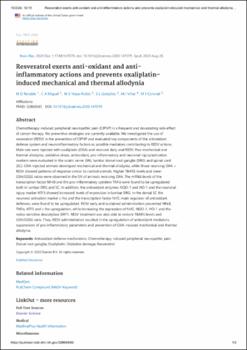| dc.contributor.author | C. A., Miguel. | |
| dc.contributor.author | Villar, Marcelo. | |
| dc.contributor.author | Coronel, María F. | |
| dc.contributor.author | Et al. | |
| dc.date.accessioned | 2024-02-15T13:16:20Z | |
| dc.date.available | 2024-02-15T13:16:20Z | |
| dc.date.issued | 2020-12 | |
| dc.identifier.citation | Brain Res . 2020 Dec 1:1748:147079. | es |
| dc.identifier.issn | 0166-4328 | |
| dc.identifier.uri | https://riu.austral.edu.ar/handle/123456789/2802 | |
| dc.description | Disponible en: https://www.sciencedirect.com/science/article/abs/pii/S0006899320304376?via%3Dihub | es |
| dc.description.abstract | Abstract
Chemotherapy-induced peripheral neuropathic pain (CIPNP) is a frequent and devastating side effect of cancer therapy. No preventive strategies are currently available. We investigated the use of resveratrol (RESV) in the prevention of CIPNP and evaluated key components of the antioxidant defense system and neuroinflammatory factors as possible mediators contributing to RESV actions. Male rats were injected with oxaliplatin (OXA) and received daily oral RESV. Paw mechanical and thermal allodynia, oxidative stress, antioxidant, pro-inflammatory and neuronal injury/activation markers were evaluated in the sciatic nerve (SN), lumbar dorsal root ganglia (DRG) and spinal cord (SC). OXA-injected animals developed mechanical and thermal allodynia, while those receiving OXA + RESV showed patterns of response similar to control animals. Higher TBARS levels and lower GSH/GSSG ratios were observed in the SN of animals receiving OXA. The mRNA levels of the transcription factor NFκB and the pro-inflammatory cytokine TNFα were found to be upregulated both in lumbar DRG and SC. In addition, the antioxidant enzymes NQO-1 and HO-1 and the neuronal injury marker ATF3 showed increased levels of expression in lumbar DRG. In the dorsal SC the neuronal activation marker c-fos and the transcription factor Nrf2, main regulator of antioxidant defenses, were found to be upregulated. RESV early and sustained administration prevented NFκB, TNFα, ATF3 and c-fos upregulation, while increasing the expression of Nrf2, NQO-1, HO-1 and the redox-sensitive deacetylase SIRT1. RESV treatment was also able to restore TBARS levels and GSH/GSSG ratio. Thus, RESV administration resulted in the upregulation of antioxidant mediators, suppression of pro-inflammatory parameters and prevention of OXA-induced mechanical and thermal allodynia.
Keywords: Antioxidant defense mechanisms; Chemotherapy-induced peripheral neuropathic pain; Dorsal root ganglia; Oxaliplatin; Oxidative damage; Resveratrol.
Copyright © 2020 Elsevier B.V. All rights reserved.
PubMed Disclaimer | es |
| dc.language.iso | en | es |
| dc.publisher | Elsevier | es |
| dc.rights | Attribution-NonCommercial-NoDerivatives 4.0 Internacional | * |
| dc.rights.uri | http://creativecommons.org/licenses/by-nc-nd/4.0/ | * |
| dc.subject | Antioxidant defense mechanisms | es |
| dc.subject | Chemotherapy-induced peripheral neuropathic pain | es |
| dc.subject | Dorsal root ganglia | es |
| dc.title | Resveratrol exerts anti-oxidant and anti-inflammatory actions and prevents oxaliplatin-induced mechanical and thermal allodynia | es |
| dc.type | Article | es |


